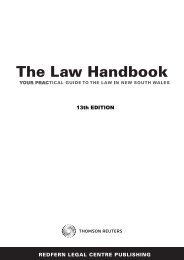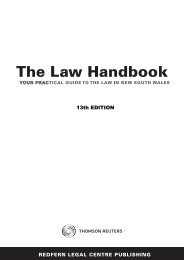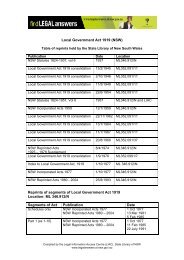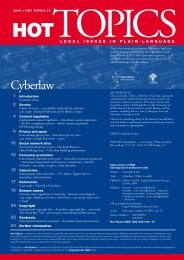Guide to termination and unfair dismissal rights of - Legal ...
Guide to termination and unfair dismissal rights of - Legal ...
Guide to termination and unfair dismissal rights of - Legal ...
- No tags were found...
Create successful ePaper yourself
Turn your PDF publications into a flip-book with our unique Google optimized e-Paper software.
Termination <strong>of</strong> EmploymentWhat is a <strong>termination</strong> <strong>of</strong> employment?In simple circumstances a <strong>termination</strong> <strong>of</strong> employment occurs where an employee’s employment is brought <strong>to</strong> anend. This may occur because <strong>of</strong> the actions <strong>of</strong> the employee or the employer. The employee may resign or theemployer may dismiss the employee, each event will result in a <strong>termination</strong> <strong>of</strong> employment.Some examples <strong>of</strong> a <strong>termination</strong> <strong>of</strong> employment brought about by an employer include the following:3• y Where an employer dismisses an employee on the basis <strong>of</strong> redundancy.•y•y•y•yWhere an employer dismisses an employer for poor performance in their job.Where an employer dismisses an employee for misconduct.Where an employer dismisses an employee for a breach <strong>of</strong> an employment contract or a breach <strong>of</strong> someother legal obligation <strong>of</strong> the employee.Where an employee is forced <strong>to</strong> resign their employment because <strong>of</strong> some action <strong>of</strong> the employer. Forexample, where the employer threatens <strong>dismissal</strong> if the employee will not resign.The employer may or may not give notice in any <strong>of</strong> the above circumstances. This does not mean that notice isnot required. In many <strong>of</strong> the above circumstances notice must be given in accordance with the FWAct. Noticeobligations will be discussed further on in this guide.Employment will also terminate in other circumstances. These circumstances may include:4• y Where an employee is employed under a fixed term contract for a specified task or for a season <strong>and</strong> thefixed term contract, task or season comes <strong>to</strong> an end.•y Where employment is under a training contract <strong>and</strong> the training period is completed <strong>and</strong> there is noagreement <strong>to</strong> continue the employment after the training period is completed.•y If the employee dies.Termination events are discussed in more detail with examples further on in this guide.What is a <strong>dismissal</strong>?The FWAct defines a <strong>dismissal</strong> by an employer as follows:(1) “A person has been dismissed if:(a)(b)(c)the person’s employment with his or her employer has beenterminated on the employer’s initiative; orthe person has resigned from his or her employment but was forced <strong>to</strong> do so because <strong>of</strong> conduct, or acourse <strong>of</strong> conduct, engaged in by his or her employer.”Strictly speaking, this definition only applies in <strong>unfair</strong> <strong>dismissal</strong> circumstances under the FWAct. Howeverit provides a helpful short statement about how a <strong>dismissal</strong> may occur. Subsection 1(a) is straightforward.Subsection 1(b) serves <strong>to</strong> reinforce the idea that where an employee is pushed by the employer <strong>to</strong> resign theresignation is a <strong>termination</strong> <strong>of</strong> employment caused by the employer. 54
















